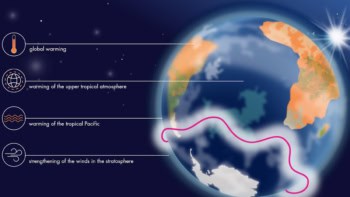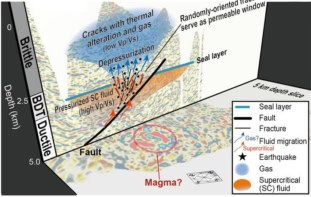The extremely complex process of projecting future emissions of carbon dioxide could be simplified dramatically by modelling civilization as a heat engine. That is the conclusion of an atmospheric physicist in the US, who has shown that changes in global population and standard of living are correlated to variations in energy efficiency. This discovery halves the number of variables needed to make emissions forecasts and therefore should considerably improve climate predictions, he claims.
Computer models used to predict how the Earth’s climate will change over the next century take as their input projections of future man-made emissions of carbon dioxide. These projections rely on the evolution of four variables: population; standard of living; energy productivity (or efficiency); and the “carbonization” of energy sources.
When multiplied together, these tell us how much carbon dioxide will be produced at a given point in the future for a certain global population. However, the ranges of values for each of the four variables combined together leads to an extremely broad spectrum of carbon-dioxide emission scenarios, which is a major source of uncertainty in climate models.
Changes in population and standard of living might best be considered as only a response to energy efficiency Timothy Garrett, University of Utah
Timothy Garrett of the University of Utah in the US believes that much of this uncertainty can be eliminated by considering humanity as if it were a heat engine (arXiv:0811.1855). Garrett’s model heat engine consists of an entity and its environment, with the two separated by a step in potential energy that enables energy to be transferred between the two. Some fraction of this transferred energy is converted into work, with the rest released beyond the environment in the form of waste heat, as required by the second law of thermodynamics.
However, the work is not done on some external task, such as moving a piston, but instead goes back to boosting the potential across the boundary separating the entity from the environment. In this way, says Garrett, the boundary “bootstraps” itself so that it can get progressively bigger and bigger, resulting in higher and higher levels of energy consumption by the entity.
Like a growing child
Garrett points out that this model serves as a basic description of what happens to a growing child, which consumes more and more energy as it increases in size, in turn allowing it to grow, resulting in still greater energy consumption, and so on. But he also believes that the model can describe the functioning of humanity as a whole, with the boundary — the sum of people, their buildings, machines etc — continually increasing in size as energy is continually removed from primary resources such as oil, coal and uranium, in turn allowing ever higher levels of energy consumption.
The goal for Garrett was to work out if there is some way of linking this thermodynamic description to economics. He believes there is. He argues that “if what physically distinguishes civilization from its environment is a thermodynamic potential, then civilization implicitly assigns monetary value to what this potential enables — the rate of energy consumption”.
Garrett proposes that the global rate of energy consumption is therefore proportional to the world’s total (inflation-adjusted) economic production generated to date. And this, he shows, leads to an interdependence between population, standard of living (in other words, economic production per person), and energy efficiency which means that only energy efficiency need be considered when predicting future trends of global energy consumption. Combined with predictions of how green or otherwise the world’s energy sources will be in the future then allows carbon-dioxide emissions to be forecast.
Bootstrapping civilization
“So, perhaps surprisingly,” he writes in his paper, “changes in population and standard of living might best be considered as only a response to energy efficiency. As part of a heat engine, creating people and their lifestyles requires energy consumption. Doing so efficiently merely serves to bootstrap civilization into a more consumptive (and productive) state by increasing the dimensions of the boundary separating civilization and its environment.” He also notes that gains in energy efficiency therefore accelerate rather than slow energy consumption, contrary to conventional wisdom.
To support his argument, Garrett plotted the relationship between global energy consumption and accumulated economic production using energy statistics from between 1970 and 2005, and found that the two were indeed proportional. He admits that this is not a very long sample period but points out that energy consumption has doubled and global GDP has tripled in this time. He says his work has received positive reviews from physicists, but less enthusiastic responses from economists.
Peter Cox, a climate scientist at the University of Exeter in the UK, says he finds the work “intriguing”, but adds he is “a little concerned that arguments from linear thermodynamics are being applied to a system — the human-environment system — which is clearly far from equilibrium.”



